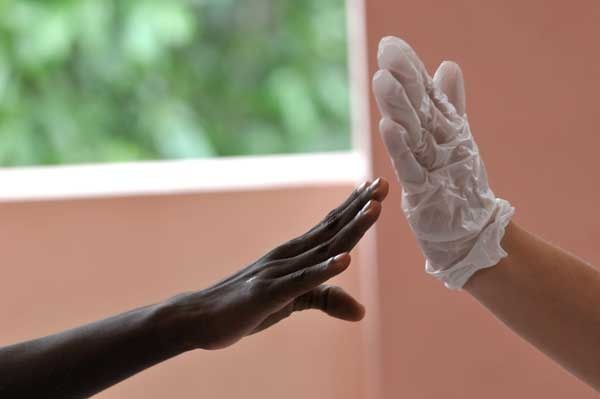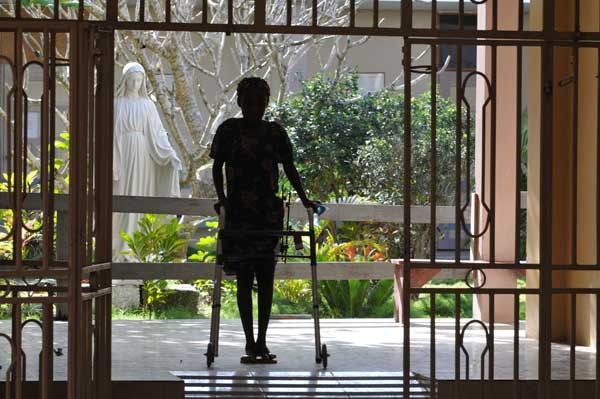Healing Hands for Haiti
photo documentary by Terry Sebastian, text by Erin Tandy
An intimate photo documentary highlighting the work of Canadian medical volunteers from Healing Hands for Haiti at St Boniface Hospital, in Haiti. In the wake of the January 2010 earthquake, they have been training local caregivers on the challenging task of rehabilitating and caring for patients with spinal cord injuries. For more information about the project, click here>>
Produced with the support of the Government of Canada through the Canadian International Development Agency.
-
2 helicop 2 helicop
A spinal cord injury patient arrives, with the help of a German pilot (not shown) and St. Boniface volunteers. The hospital's willingness to take on challenging cases has made a huge difference for patients with spinal injuries. According to Dr. Colleen O'Connell, Team Canada's founder and the head of this mission, without the help of hospitals like St. Boniface that began accepting spinal cord injury patients, these patients would likely have died.

-
1 arial 1 arial
A bird's-eye view of St. Boniface Hospital in Fond-des-Blancs, a rural town about 70 miles outside Port-au-Prince. The hospital, untouched by the earthquake, began accepting patients with spinal cord injuries who were recovering from operations performed at other hospitals and in need of rehabilitation.

-
3 hands 3 hands
Team Canada volunteer Jodi Powell offers a healing hand to 12-year-old earthquake survivor Vladami. When they arrived, Powell and the rest of the five-member team began assessing patients at St. Boniface to determine their treatment needs.

-
4 silhouette 4 silhouette
Team Canada came to St. Boniface to teach staff and caregivers how to manage their patients' injuries, in addition to teaching the patients how to take care of themselves. Here, a young patient tours the hospital under her own power.

-
8 smile 8 smile
Twelve-year-old Sony was trapped in the rubble for three days, but his rescue only marked the beginning of another nightmare: he was transported from place to place because no one knew how to treat his injuries. Now, Canadian physiotherapist Dorothy Drost describes him as her star patient. "Five days ago Sony couldn't walk. He's now my success story," she says.

-
5 bubbles 5 bubbles
Young survivor Ismerilie takes time out from her treatment to relax. The 12-year-old suffered a broken hip and arm in the earthquake.

-
7 loss 7 loss
The pain of recovery is not always physical. For 22-year-old Personna, who is now a paraplegic, rehabilitation has been especially difficult because he lost most of his family on January 12.

-
6 pain 6 pain
Evelyne struggles to get out of her wheelchair, with some encouragement from Jodi Powell, an occupational therapist from Ottawa. Evelyne is just 18 years old and will likely never fully recover from a cranial fracture she incurred during the quake.

-
9 ball 9 ball
Maxxo is not only aiming for a strike, but also improving his upper body strength. Bowling, along with other daily activities like practicing getting in and out of wheelchairs, are being introduced by Team Canada to help patients gain both strength and independence.

-
10 computer 10 computer
The Team Canada-funded wheelchairs not only have health benefits, but will also provide something much more important: independence. The chairs will allow former patients to be mobile in their homes, and even transfer themselves to their beds on their own. Volunteers Dorothy Drost, Betsy Sherwood and Jodi Powell work out the details of the order.

-
11 group 11 group
Since the quake struck, the Haitian government has expressed a desire to bring accredited physiotherapy and occupational therapy training to the country. Team Canada aims to mentor these future students, and to continue to educate Haitians to provide the necessary care.

A spinal cord injury patient arrives, with the help of a German pilot (not shown) and St. Boniface volunteers. The hospital's willingness to take on challenging cases has made a huge difference for patients with spinal injuries. According to Dr. Colleen O'Connell, Team Canada's founder and the head of this mission, without the help of hospitals like St. Boniface that began accepting spinal cord injury patients, these patients would likely have died.
A bird's-eye view of St. Boniface Hospital in Fond-des-Blancs, a rural town about 70 miles outside Port-au-Prince. The hospital, untouched by the earthquake, began accepting patients with spinal cord injuries who were recovering from operations performed at other hospitals and in need of rehabilitation.
Team Canada volunteer Jodi Powell offers a healing hand to 12-year-old earthquake survivor Vladami. When they arrived, Powell and the rest of the five-member team began assessing patients at St. Boniface to determine their treatment needs.
Team Canada came to St. Boniface to teach staff and caregivers how to manage their patients' injuries, in addition to teaching the patients how to take care of themselves. Here, a young patient tours the hospital under her own power.
Twelve-year-old Sony was trapped in the rubble for three days, but his rescue only marked the beginning of another nightmare: he was transported from place to place because no one knew how to treat his injuries. Now, Canadian physiotherapist Dorothy Drost describes him as her star patient. "Five days ago Sony couldn't walk. He's now my success story," she says.
Young survivor Ismerilie takes time out from her treatment to relax. The 12-year-old suffered a broken hip and arm in the earthquake.
The pain of recovery is not always physical. For 22-year-old Personna, who is now a paraplegic, rehabilitation has been especially difficult because he lost most of his family on January 12.
Evelyne struggles to get out of her wheelchair, with some encouragement from Jodi Powell, an occupational therapist from Ottawa. Evelyne is just 18 years old and will likely never fully recover from a cranial fracture she incurred during the quake.
Maxxo is not only aiming for a strike, but also improving his upper body strength. Bowling, along with other daily activities like practicing getting in and out of wheelchairs, are being introduced by Team Canada to help patients gain both strength and independence.
The Team Canada-funded wheelchairs not only have health benefits, but will also provide something much more important: independence. The chairs will allow former patients to be mobile in their homes, and even transfer themselves to their beds on their own. Volunteers Dorothy Drost, Betsy Sherwood and Jodi Powell work out the details of the order.
Since the quake struck, the Haitian government has expressed a desire to bring accredited physiotherapy and occupational therapy training to the country. Team Canada aims to mentor these future students, and to continue to educate Haitians to provide the necessary care.










